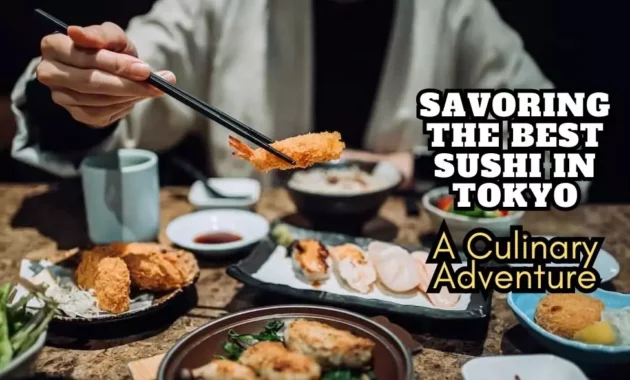When it comes to sushi, there’s no better place to indulge than Tokyo. The Japanese capital is renowned for its rich culinary culture and its exquisite sushi offerings, which attract foodies and sushi enthusiasts from all over the world. From Michelin-starred restaurants to hidden sushi gems tucked away in Tokyo’s alleys and streets, the city offers an endless array of sushi experiences to explore.
In this article, we’ll take you on a culinary adventure through Tokyo’s sushi scene, from its origins and evolution to its top sushi restaurants and regional specialties. We’ll also share tips and etiquette for enjoying sushi in Tokyo and provide recommendations for exploring the city’s sushi alleys and markets. So buckle up and get ready to savor the best sushi in Tokyo!
The Origins of Sushi and Its Evolution in Japan
Before we dive into Tokyo’s sushi scene, let’s take a quick look at the history of sushi and how it has evolved in Japan. Sushi originated in Southeast Asia as a way to preserve fish by fermenting it with rice.
This technique was brought to Japan in the eighth century and gradually evolved into the sushi we know and love today.
In the early days, sushi was a simple snack made of fish and rice. However, over time, sushi chefs in Japan began to experiment with different ingredients and techniques, leading to the development of various types of sushi, such as nigiri, maki, and temaki.
Today, sushi is a sophisticated art form, with chefs spending years perfecting their craft and sourcing the freshest and highest quality ingredients.
Tokyo’s Top Sushi Restaurants: An Overview
If you’re looking for the best sushi in Tokyo, you’ll be spoiled for choice. The city is home to numerous sushi restaurants, ranging from high-end, Michelin-starred establishments to local sushi bars tucked away in quiet neighborhoods. Here are some of Tokyo’s top sushi restaurants to consider:
1. Sukiyabashi Jiro
This legendary sushi restaurant, located in the Ginza district, has earned three Michelin stars and is considered by many to be the best sushi restaurant in the world. Run by the octogenarian sushi master Jiro Ono, who has been making sushi for over 70 years, Sukiyabashi Jiro offers an unforgettable dining experience that is both traditional and innovative. The restaurant only seats 10 diners at a time, so booking in advance is essential.

2. Sushi Saito
This three-Michelin-starred restaurant is widely considered to be one of the best sushi restaurants in the world. Chef Takashi Saito serves up a range of sushi dishes, using only the freshest and highest quality ingredients. Chef Takashi Saito sources his ingredients from the Tsukiji fish market and other local markets to create an unforgettable sushi experience.
3. Sushi Yoshitake
Chef Masahiro Yoshitake is known for his innovative approach to sushi, combining traditional techniques with modern touches. Sushi Yoshitake, located in the heart of Ginza, has earned three Michelin stars and is considered one of Tokyo’s top sushi destinations. Sushi Yoshitake offers an intimate dining experience, with only seven seats at the counter. Chef Masahiro Yoshitake serves up a range of sushi dishes, using seasonal and local ingredients.
4. Sushi Sora
This Michelin-starred restaurant is located on the 38th floor of the Mandarin Oriental Hotel, offering stunning views of the city skyline. Chef Yuji Imaizumi serves up a range of sushi dishes, using only the freshest and highest quality ingredients.
5. Kyubey
This popular sushi restaurant has been around for over 80 years and is known for its classic Edo-style sushi. Located in the Ginza district, Kyubey offers a relaxed and welcoming atmosphere, with a focus on the quality of the sushi and the experience of the diner.
6. Sushisho Masa
Chef Masakatsu Oka, who trained under Jiro Ono, runs this cozy and intimate sushi restaurant in the Akasaka district. Sushisho Masa offers a unique and personalized sushi experience, with Chef Oka tailoring each course to the diner’s preferences and dietary restrictions.
Insider Tips for Finding the Best Sushi in Tokyo
While the above restaurants are undoubtedly some of the best sushi restaurants in Tokyo, there are also some hidden gems to be found. Here are some insider tips for finding the best sushi in Tokyo:
- Venture Off the Beaten Track: While many of the best sushi restaurants in Tokyo are located in the city center, there are also some excellent options in the suburbs. For example, the Michelin-starred restaurant Sushi Iwa is located in the residential area of Ginza, serving up high-quality sushi dishes in a traditional setting.
- Try a Standing Sushi Bar: If you’re looking for a more casual dining experience, why not try a standing sushi bar? These are typically small, no-frills establishments that serve up fresh and tasty sushi at affordable prices. Some popular options include Uogashi Nihon-Ichi and Sushi Zanmai.
- Look for Lunchtime Deals: Many sushi restaurants in Tokyo offer lunchtime deals, which can be a great way to sample some high-quality sushi without breaking the bank. For example, Sushi Kanesaka offers a lunchtime omakase menu for around 5,000 yen.
Mastering the Art of Sushi: What to Look for in a Sushi Chef
The key to a great sushi experience is, of course, the sushi chef. A skilled sushi chef can elevate even the simplest sushi to a sublime culinary experience. When choosing a sushi restaurant in Tokyo, here are some qualities to look for in a sushi chef:
1. Experience
Look for a sushi chef who has trained for many years under a master chef and has extensive knowledge of the ingredients and techniques involved in sushi making.
2. Attention to detail
A good sushi chef pays close attention to every detail of the sushi-making process, from selecting the fish to shaping the rice to creating the perfect balance of flavors.
3. Creativity
While traditional techniques are important in sushi making, a great sushi chef also has a creative streak and is willing to experiment with new flavors and techniques.
4. Personality
A sushi chef who is friendly and welcoming can make the dining experience all the more enjoyable, especially if you’re sitting at the counter and watching the chef at work.
Nigiri, Maki, and More: A Guide to the Different Types of Sushi
When it comes to sushi, there’s more to it than just the classic nigiri and maki rolls. Here are some of the different types of sushi you’ll find in Tokyo:
1. Nigiri
The most iconic type of sushi, nigiri consists of a slice of raw fish or other seafood placed on a small bed of vinegared rice.
2. Maki
Maki rolls consist of rice and fillings (such as raw fish, vegetables, or egg) rolled in seaweed and sliced into bite-sized pieces.
3. Temaki
Temaki rolls are similar to maki rolls but are made into a cone shape, with the ingredients wrapped in seaweed and rice.
4. Chirashi
Chirashi is a bowl of sushi rice topped with a variety of sashimi (raw fish) and other toppings.
5. Oshi
Oshi sushi is a type of pressed sushi made by layering fish and other ingredients in a box-shaped mold and compressing them with a weighted lid.
Beyond the Basics: Exploring Unusual Sushi Varieties
While traditional sushi varieties like nigiri and maki are popular in Tokyo, the city also offers some more unusual and creative sushi options. Here are some sushi varieties to try if you’re feeling adventurous:
1. Fugu
Fugu, or blowfish, is a delicacy in Japan that requires a highly skilled chef to prepare. The fish contains a deadly toxin that can be fatal if not removed correctly, making it a risky but highly sought-after sushi experience.
2. Uni
Uni, or sea urchin, is a creamy and slightly sweet sushi topping that is beloved by many sushi aficionados.
Ikura: Ikura, or salmon roe, is a popular sushi topping that adds a burst of salty flavor to each bite.
3. Anago
Anago, or saltwater eel, is a softer and sweeter alternative to the more commonly used unagi (freshwater eel) in sushi.
4. Tamago
Tamago, or sweet egg omelet, is a common sushi topping that is often served as the final course of a sushi meal.
Tips for Enjoying the Best Sushi in Tokyo
Now that you know where to find the best sushi in Tokyo and what types of sushi to try, here are some tips for making the most of your sushi experience:
- Sit at the counter: If possible, try to sit at the sushi counter where you can watch the sushi chef at work and ask questions about the ingredients and techniques.
- Eat the sushi in one bite: Traditionally, sushi is meant to be eaten in one bite to fully appreciate the combination of flavors and textures.
- Use your hands: It’s acceptable to eat sushi with your hands rather than chopsticks, especially for nigiri sushi.
- Don’t dip the rice: When using soy sauce to flavor your sushi, dip only the fish side into the sauce, not the rice side.
- Follow the chef’s lead: If you’re not sure how to eat a certain type of sushi, don’t be afraid to ask the sushi chef for guidance.
Conclusion
Tokyo is a sushi lover’s paradise, with countless restaurants offering the freshest and most delicious sushi you’ll ever taste. Whether you’re a sushi aficionado or a newcomer to the world of sushi, Tokyo is the perfect destination to sample some of the best sushi in the world.
From high-end Michelin-starred restaurants to casual standing sushi bars, there is something to suit every taste and budget. From the classic nigiri and maki to the more unusual and creative sushi varieties, each sushi experience is a culinary adventure that you won’t soon forget.
So if you’re planning a trip to Tokyo, be sure to check out some of the best sushi restaurants in the city and discover your own personal favorite. Grab your chopsticks (or use your hands!) and savor the best sushi in Tokyo.
FAQs About Finding the Best Sushi in Tokyo
Q: What is the difference between nigiri and sashimi?
A: Nigiri is a type of sushi that consists of a small ball of rice topped with a piece of raw fish, while sashimi is simply sliced raw fish without any rice.
Q: What is omakase?
A: Omakase is a type of dining experience in which the chef selects the dishes for you, typically consisting of a range of sushi dishes.
Q: How much should I expect to pay for sushi in Tokyo?
A: The cost of sushi in Tokyo can vary widely depending on the restaurant and the quality of the ingredients. High-end sushi restaurants can cost upwards of 30,000 yen per person, while more casual options can be found for under 1,000 yen.
Q: Is it necessary to speak Japanese to order sushi in Tokyo?
A: While it can be helpful to know some basic Japanese phrases, many sushi restaurants in Tokyo have English menus and staff who can speak some English.


